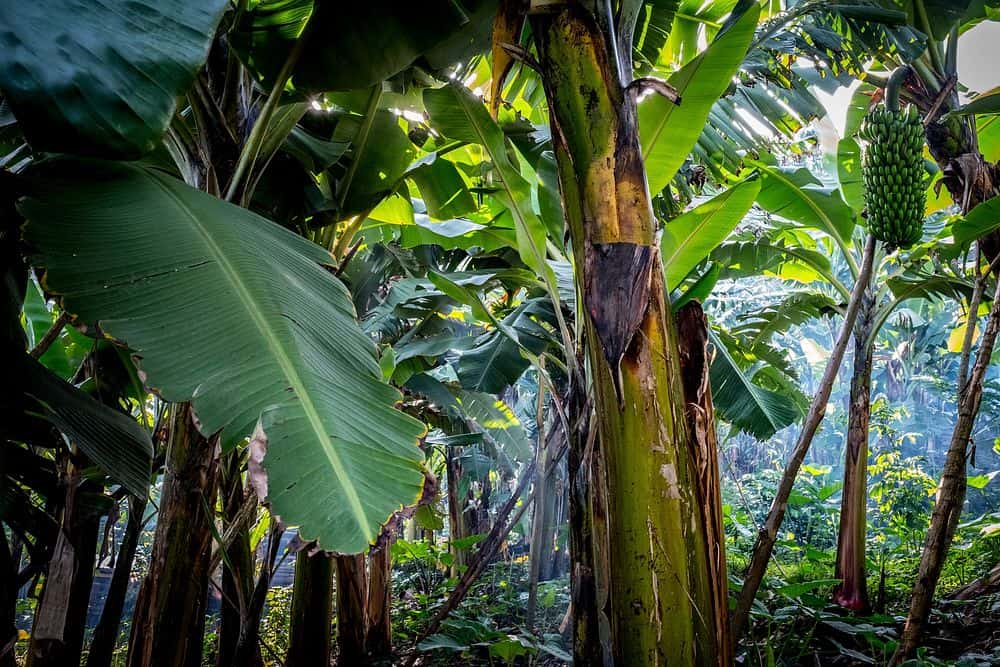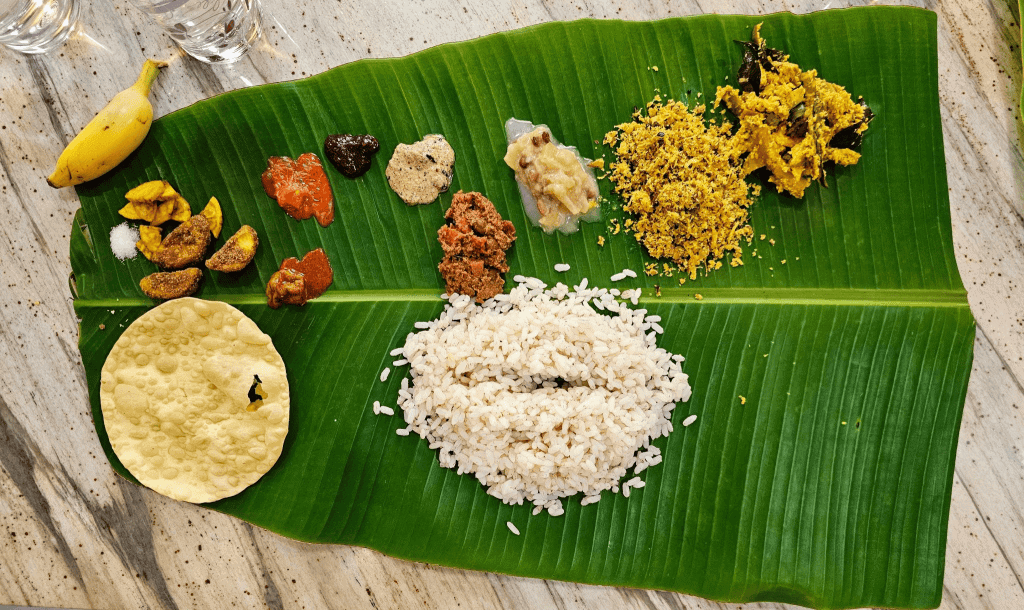From temple rituals to taco wraps, spa treatments to street food—banana leaves have been out there doing it all for centuries!

As the world races towards eco-friendly solutions, it’s fascinating to see how banana leaves have been ahead of the curve for centuries. From traditional medicine in India and Sri Lanka to healing rituals in the Pacific Islands and modern sustainability movements, this humble leaf has always been a force of nature—literally and figuratively.
The usefulness of banana leaves stretches back thousands of years, with traces of their role as natural plates and bowls found in the Indus Valley Civilization as early as 2000 BC. One of the world’s oldest urban civilizations embraced them, proving that this eco-friendly wisdom has stood the test of time.
A Global Culinary Treasure
At many South Indian weddings, guests are welcomed with a grand feast served on a giant, vibrant green banana leaf. No forks, no spoons—just the time-honored tradition of eating with hands, savoring every bite, and experiencing flavors in their purest, most natural form.

But South India isn’t the only place where banana leaves steal the show. Travel to Mexico, and you’ll find tamales—delicious masa (corn dough) pockets filled with meats, cheeses, or chilies—wrapped in these same leaves before being steamed to perfection. It’s not just about convenience; the banana leaf infuses the dish with a subtle, earthy aroma, making the meal even more flavorful. From Hindu rituals to Thai water festivals, Amazonian jungle kitchens to Vietnamese street food stalls, banana leaves have been an integral part of cultures worldwide.
- India & Sri Lanka: Used in traditional feasts like Onam Sadhya and Tamil Nadu’s banana leaf meals, it enhances flavors and is believed to have antimicrobial properties.
- Mexico & Central America: Tamales wrapped in banana leaves are a staple in Mexican and Guatemalan cuisines, providing moisture and flavor during cooking.
- Thailand & Southeast Asia: Used in wrapping fish, sticky rice, and desserts like Khao Tom Mat, a sweet coconut banana treat.
- The Amazon & Philippines: In parts of the Amazon and the Philippines, banana leaves replace aluminum foil for grilling and steaming fish, chicken, and even rice cakes.
- Vietnam: Eco-friendly food packaging in markets and restaurants is making a comeback with banana leaves replacing plastic wrapping.
Banana Leaves: A Spiritual Messenger
Banana Leaves are also considered to hold deep spiritual significance. Across continents—from Asia to Africa, the Pacific Islands and beyond—the humble banana leaf symbolises purity, prosperity, and devotion in rituals, festivals, and sacred traditions.

In India and Sri Lanka, no Hindu puja, wedding, or temple ritual is complete without the banana leaf. Its broad, untainted surface is believed to enhance the sanctity of sacred offerings, making it a divine vessel for Prasadam (holy food).
At South Indian temples, it’s customary to serve prasadam on fresh banana leaves, ensuring the meal retains its spiritual essence. Take the Tirupati Temple, one of the world’s richest temples, where banana leaves play a key role in preparing and serving the famous Tirupati Laddu, a much-revered offering to Lord Venkateswara.
It also graces weddings, where the plant’s large, sturdy leaves adorn the wedding mandap, standing tall as symbols of fertility, longevity, and prosperity. During Vara Mahalakshmi Vrata, a festival dedicated to Goddess Lakshmi, banana leaves are placed in worship, reinforcing their role as bearers of good fortune.

Venturing east to Thailand and Indonesia, banana leaves become spiritual messengers in offerings and festivals.
- In Thailand’s Loy Krathong festival, thousands of krathongs—small floating rafts made of banana leaves, candles, and flowers—are gently released onto rivers as offerings to the water goddess. Watching these glowing krathongs drift under the moonlight is a moment of peace, renewal, and gratitude.
- In Bali, Indonesia, Canang Sari—small woven banana leaf baskets filled with flowers and incense—are placed outside homes and temples every day as a gesture of devotion, balance, and gratitude to gods and ancestors.
Beyond Asia, banana leaves take on an equally spiritual and cultural role in West Africa and the Pacific Islands.
- In Ghana and Nigeria, banana leaves are used in large feasts to wrap food, sealing in flavors, blessings, and tradition. These meals are more than just nourishment; they are a sacred bond between people and their ancestors.
- In the Pacific Islands, Polynesians honor ancestral traditions by using banana leaves in earth ovens, cooking meals in a way that respects both nature and heritage. During ancestral worship ceremonies, banana leaves are laid out as a sign of respect, connection, and spiritual offering.
Ancient Healing: A Natural Medicine for the Ages
For generations, banana leaves have been a staple in Ayurveda, herbal medicine, and indigenous healing systems, revered for their cooling, detoxifying, and anti-inflammatory properties.
- In India, Ayurveda prescribes banana leaf wraps in therapeutic steam baths to draw out toxins and restore balance to the doshas (body energies). The leaves’ cooling nature is believed to soothe heat-related ailments and aid in detoxification.
- In Sri Lanka, fresh banana leaves are traditionally placed under feverish patients to naturally regulate body temperature—a simple, medicine-free remedy still used in rural areas today.
- In Hawaii, within the la’au lapa’au (traditional medicine) system, mashed banana leaf paste is applied to burns and wounds, accelerating healing and reducing inflammation, much like a natural antiseptic dressing.
- In Fiji, newborn babies are sometimes swaddled in banana leaves to protect their delicate skin from heat rashes, a practice passed down through generations as a way to keep babies cool in the tropical climate.
Banana leaves are also used in Ayurvedic skincare—their extracts are incorporated into face packs and herbal pastes, promoting hydration, skin healing, and protection against infections.
A Green Alternative: The Banana Leaf’s Role in Sustainable Living
While the world searches for alternatives to plastic, banana leaves have been doing the job effortlessly for centuries. Their biodegradable, chemical-free, and antibacterial properties make them the ultimate eco-friendly choice for food packaging, dining, and everyday use.

- In South India, banana leaves have long replaced disposable plates, offering a sturdy, natural, and waste-free dining solution. Now, many modern restaurants are embracing this ancient practice, with banana leaf plates appearing in eco-conscious dining movements worldwide.
- In Thailand, supermarkets have started wrapping fresh produce in banana leaves instead of plastic, creating a sustainable, cost-effective solution to plastic pollution. This trend is gaining momentum, inspiring similar eco-friendly packaging initiatives across Vietnam, Indonesia, and India.
- In Vietnam and the Philippines, street food vendors are returning to their roots, using banana leaves to wrap rice, meats, and sweets, reducing the reliance on plastic containers and styrofoam packaging.
From Ancient Wisdom to a Greener Future
From healing fevers in Sri Lanka to replacing plastic in Thai markets, banana leaves bridge tradition, wellness, and sustainability. They are not just a piece of greenery—they are a symbol of wisdom from the past, guiding us toward a greener, healthier future. Who knew a humble green leaf could be such a globetrotter, flavor enhancer, and sustainability warrior all at once?
Read more: Latest



